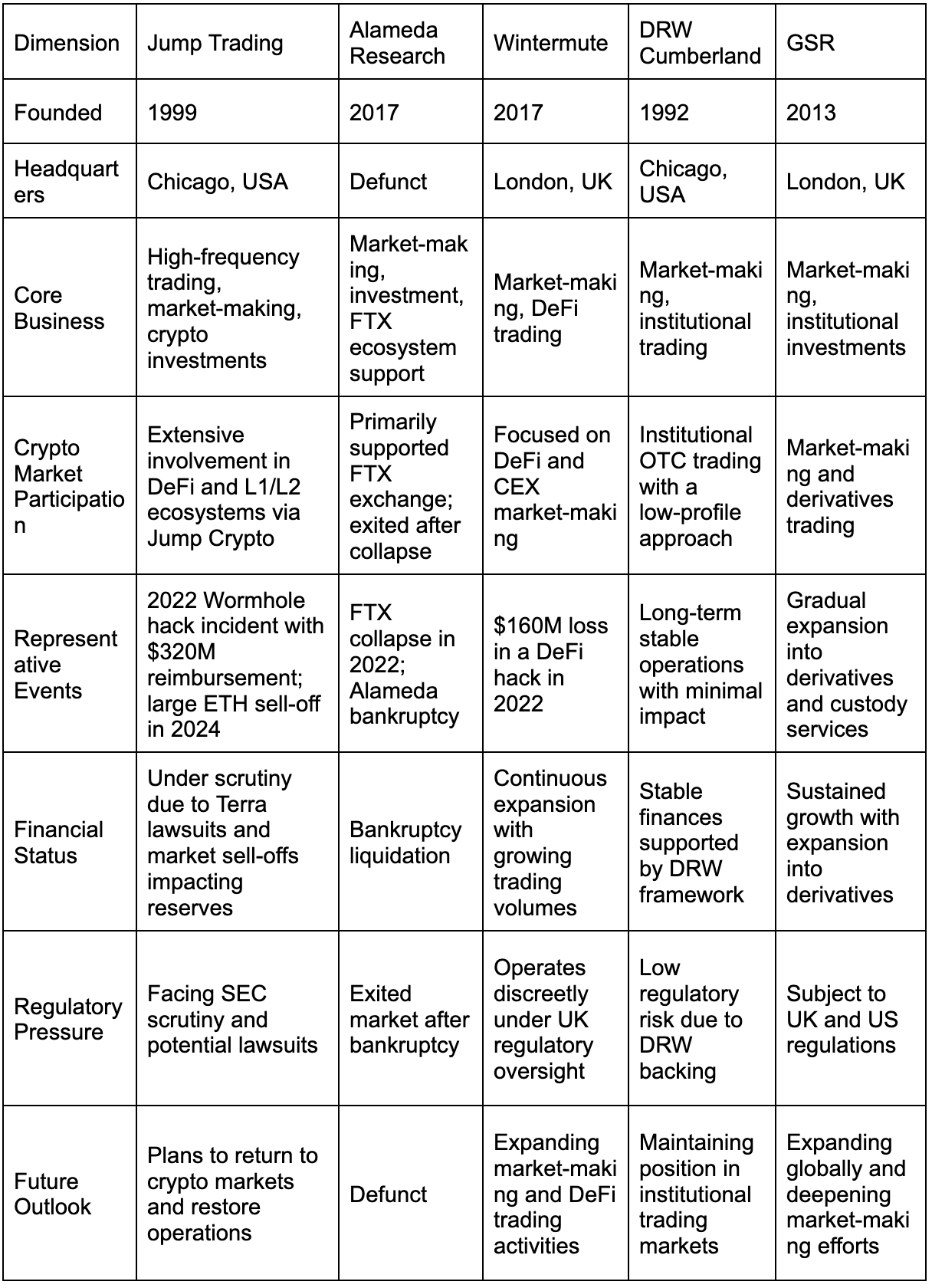Jump Trading Dan Portofolionya
Pengantar
Jump Trading adalah perusahaan perdagangan frekuensi tinggi dan algoritmik yang terkenal secara global yang didirikan pada tahun 1999, dengan markas besarnya di Chicago, Amerika Serikat. Divisi kripto nya, Jump Crypto, didirikan pada tahun 2015 dan telah terlibat secara mendalam dalam ruang blockchain dan aset digital selama bertahun-tahun, menjadi pemain kunci di pasar kripto.
Pada tahun 2021, Jump berpartisipasi dalam perdagangan Terra UST, menciptakan permintaan buatan dengan mendorong harga naik untuk mengamankan keuntungan jangka pendek. Namun, setelah kejatuhan Terra UST, Jump dihadapkan pada tuduhan pidana atas dugaan manipulasi harga, yang sangat mempengaruhi posisinya di industri kripto. Kebangkrutan FTX lebih memperparah tekanan keuangannya dan sangat mempengaruhi perkembangan Jump Crypto.
Pada Agustus 2024, Jump Trading sekali lagi menjadi pusat perhatian pasar akibat kejadian penjualan besar-besaran tiba-tiba, yang memicu diskusi luas. Sekarang, Jump berusaha untuk memulai kembali bisnis kripto dan menyesuaikan posisi strategisnya. Artikel ini akan meninjau lanskap investasinya dan peristiwa kunci, menjelajahi apakah Jump Trading dapat pulih dengan sukses dan alasan-alasan lebih mendalam di balik kembalinya ke pasar pada saat ini.

Sumber: https://www.jumptrading.com/
Portofolio Investasi Kripto
Bisnis inti Jump Trading berfokus pada perdagangan frekuensi tinggi, tetapi divisi kripto Jump, Jump Crypto, telah memainkan berbagai peran dalam ekosistem blockchain, termasuk pembuatan pasar, investasi ventura, dan pengembangan infrastruktur.
Menurut informasi yang tersedia secara publik, Jump Crypto telah terlibat secara mendalam dalam beberapa proyek besar, seperti Solana, Terra, dan jembatan lintas-rantai Wormhole. Ekosistem Solana adalah salah satu area investasi kunci Jump Crypto, di mana mereka telah menyediakan likuiditas dan dukungan teknis untuk membantu pertumbuhan blockchain tersebut.
Selain itu, Jump telah berpartisipasi dalam putaran pendanaan tahap awal untuk beberapa proyek DeFi dan NFT, seperti putaran pendanaan Seri A senilai $60 juta untuk Figure Markets pada Maret 2024.
Namun, portofolio investasi Jump Crypto tidaklah tanpa hambatan. Runtuhnya ekosistem Terra pada tahun 2022 menyebabkan kerugian, dan dokumen pengadilan AS mengungkapkan bahwa Jump Trading telah meraup keuntungan hampir $1.3 miliar dari perdagangan UST Terra, yang menyebabkan gugatan class-action.
Selain itu, kejatuhan FTX pada tahun 2022 dan peretasan Wormhole menambah tekanan keuangan pada operasi Jump. Kejadian-kejadian ini kadang-kadang merusak reputasi Jump di dalam komunitas kripto.

Sumber: https://www.rootdata.com/Projects/detail/Figure%20Markets?k=MTE5MjA%3D
Karakteristik Investasi
Investment Focus: Terutama berinvestasi di proyek blockchain, cryptocurrency, dan Web3 tahap awal hingga awal, mencakup area seperti Layer 1 (misalnya, Solana, Aptos), DeFi, NFT, dan infrastruktur.
Peran Pasar: Bertindak sebagai pembuat pasar utama, menyediakan likuiditas untuk beberapa token sambil berpartisipasi dalam perdagangan dan optimasi pasar.
Proyek Terkenal: Telah berinvestasi dan mendukung proyek-proyek ekosistem Solana seperti Serum, Wormhole, dan Pyth, serta proyek-proyek terkenal lainnya seperti Sei, TIA, dan Sui.
Dukungan Teknis: Menyediakan sumber daya rekayasa dan pengembangan, berkontribusi pada proyek sumber terbuka (misalnya, Jaringan Pyth) untuk meningkatkan kemampuan teknologi ekosistem.
Signifikansi:
Melalui investasi dan pengembangan infrastruktur, Jump Crypto telah mendorong pertumbuhan dan kematangan pasar kripto, membuka potensi jaringan sumber terbuka yang didorong oleh komunitas, terutama di sektor blockchain berkinerja tinggi dan DeFi.

Sumber: https://www.rootdata.com/Investors/detail/Jump%20Trading?k=MTEyOTU%3D
Garis Waktu Acara Kunci
Februari 2022: Protokol lintas-rantai Wormhole milik Jump Trading diretas, mengakibatkan kerugian sekitar $320 juta. Jump Trading segera campur tangan untuk menstabilkan sentimen pasar dan menggantikan dana yang dicuri.
November 2023: Jump Trading memutuskan untuk memisahkan Wormhole sebagai entitas independen, yang menyebabkan kepindahan para eksekutif kunci, termasuk CEO Saeed Badreg dan COO Anthony Ramirez.
Agustus 2024: Menurut data Arkham, stablecoin menyumbang 96% dari total portofolio investasi Jump Trading, senilai sekitar $595 juta, termasuk $468 juta dalam USDC dan $103 juta dalam USDT.
Agustus 2024: Selama "Black Monday" di pasar keuangan global, Jump Crypto melakukan aksi jual besar-besaran, terutama berfokus pada Ethereum (ETH). Data menunjukkan bahwa Jump menjual ETH senilai lebih dari $ 300 juta, termasuk aset yang tidak dipertaruhkan dari Lido. Langkah ini dipandang sebagai salah satu faktor di balik jatuhnya pasar crypto. Spekulasi muncul bahwa aksi jual itu terkait dengan penyelesaian $ 4,47 miliar dalam kasus Terra, memaksa Jump untuk melikuidasi aset untuk mengatasi tekanan keuangan potensial.
Setelah Agustus 2024: Setelah acara penjualan, Jump Trading mengadopsi sikap rendah hati. Dalam beberapa bulan berikutnya, berita perusahaan terutama berkisar pada restrukturisasi internal dan gugatan eksternal. Pengawasan regulasi, gugatan investor, dan penurunan kepercayaan menyebabkan stagnasi dalam bisnis Jump Crypto.
Maret 2025: Saat pasar pulih secara bertahap, Jump Trading mengumumkan kebangkitan penuh bisnis kripto-nya. Menurut CoinDesk, Jump sedang merombak sumber daya dan bersiap untuk kembali ke perdagangan dan investasi kripto. Pada saat ini, sekitar tujuh bulan telah berlalu sejak krisis penjualan, dan pasar kripto mulai pulih dari titik terendahnya pada Agustus 2024.

Sumber: https://x.com/ScopeProtocol/status/1820417458215510412Maaf, teks sumber tidak dapat diterjemahkan. Silakan coba lagi dengan teks sumber yang valid.
Persaingan Industri
Jump Trading memiliki kemampuan teknis dan keuangan yang kuat, tetapi kontroversi penjualan baru-baru ini dan tekanan regulasi telah menimbulkan tantangan signifikan. Sebaliknya, Wintermute dan GSR terus berkembang dengan agresif, sementara DRW Cumberland menjaga stabilitas dengan memanfaatkan sumber daya keuangan tradisional. Namun, Alameda Research telah sepenuhnya keluar dari pasar setelah kejatuhan FTX.
Dampak Pencipta Pasar pada Pasar Kripto
Peran dan Mekanisme Market Maker:
Jump Trading di Pasar Tradisional: Model ini menyediakan likuiditas melalui perdagangan frekuensi tinggi (HFT) dan algoritma, memastikan spread bid-ask yang stabil sambil mendapatkan keuntungan kecil namun konsisten. Ini bergantung pada infrastruktur teknologi yang tangguh dan perdagangan dengan latensi rendah.
Jump Crypto di Pasar Crypto: Ini menyediakan likuiditas untuk proyek-proyek seperti Solana, Aptos, dan Jaringan Pyth, bertindak sebagai pembuat pasar dengan menempatkan pesanan di bursa dan menyesuaikan kedalaman buku pesanan untuk menstabilkan harga. Ini juga mendukung penawaran token baru dan aktivitas pasangan perdagangan.
Bagaimana Market Makers Mempengaruhi Pasar:
Dampak Positif:
Meningkatkan Likuiditas: Jump Crypto terus-menerus memberikan penawaran beli dan jual di pasar kripto yang sangat fluktuatif, mengurangi slippage dan membantu pedagang ritel dan institusi melakukan perdagangan dengan lebih efisien.
Stabilitas Harga: Penyesuaian kedalaman pesanan mencegah fluktuasi harga ekstrem, terutama pada proyek-proyek tahap awal seperti Solana atau Sei selama fase penerbitan token mereka.
Dukungan Ekosistem: Jump memberikan dukungan pasar untuk proyek-proyek yang diinvestasikannya (misalnya, Wormhole, Pyth), memperkuat adopsi dan pertumbuhan.
Potensi Risiko Manipulasi:
Keunggulan Informasi: Latar belakang kuantitatif Jump Trading dan keterlibatan mendalam Jump Crypto dalam proyek (misalnya, penyediaan data Pyth) mungkin memungkinkan mereka untuk mengakses dinamika pasar lebih awal, menggunakan posisi pembuat pasar mereka untuk menyesuaikan penawaran atau likuidasi posisi.
Konsentrasi Kekuasaan: Sebagai pembuat pasar utama, jika Jump Crypto mengontrol sebagian besar likuiditas token, hal itu bisa menciptakan penjualan panik ("dumping") atau mendorong harga naik ("pumping") dengan tiba-tiba menarik pesanan atau melebarkan spread.
Wash Trading: Di pasar kripto yang sedikit diatur, pembuat pasar mungkin terlibat dalam perdagangan palsu - menggelembungkan volume perdagangan secara artifisial untuk menarik investor ritel sebelum mendapatkan keuntungan dan keluar. Misalnya, selama pasar banteng kripto 2017-2018, pembuat pasar dituduh memanipulasi harga token kap kecil.
Memicu Likuidasi: Di pasar perdagangan ber-leverage (seperti DeFi atau bursa terpusat), manipulasi harga yang tepat bisa memicu pesanan stop-loss atau ambang likuidasi, memaksa pedagang lain mengalami kerugian.
Studi Kasus Jump:
Ekosistem Solana: Jump Crypto memberikan dukungan likuiditas yang signifikan kepada Solana pada awal kemunculannya, membantu harga dan volume perdagangan tumbuh dengan cepat. Namun, setelah kejatuhan FTX pada tahun 2022, harga Solana anjlok, menimbulkan kekhawatiran pasar tentang apakah Jump telah menggunakan posisi pembuat pasarannya untuk keluar lebih awal demi keuntungan (meskipun tidak ditemukan bukti langsung).
Jaringan Pyth: Sebagai penyedia data inti dan pembuat pasar, Jump diduga memiliki kemampuan untuk memengaruhi protokol DeFi yang mengandalkan data oracle dan likuiditas Pyth, dengan tidak langsung memanipulasi pasar.
Batasan Manipulasi Pasar:
Legalitas: Pembuat pasar legal dalam keuangan tradisional, tetapi di pasar kripto, karena kurangnya regulasi yang seragam, tindakan mereka sering beroperasi di area abu-abu. Misalnya, SEC AS telah menyelidiki strategi HFT Jump Trading tetapi tidak mengeluarkan tuduhan yang jelas.
Transparansi: Pasar kripto kurang transparan, sehingga sulit untuk sepenuhnya melacak volume perdagangan Jump Crypto dan strategi penempatan order, meningkatkan risiko manipulasi.
Kesimpulan:
Jump Trading dan Jump Crypto, sebagai pembuat pasar, telah signifikan meningkatkan efisiensi pasar melalui keunggulan teknologi dan modal mereka. Namun, potensi mereka untuk memanipulasi pasar—baik melalui asimetri informasi maupun konsentrasi likuiditas—masih kontroversial. Sampai kerangka regulasi diperkuat, investor ritel sebaiknya berhati-hati terhadap kedalaman pasar yang mendasari dan fluktuasi harga, terutama dalam proyek-proyek di mana Jump terlibat secara signifikan.

Sumber: https://www.sec.gov/newsroom/press-releases/2024-166
Keuntungan dan Potensi untuk Kembali
Apakah Jump Trading dapat membuat comeback bergantung pada beberapa faktor kunci:
Kekuatan Teknis dan Keuangan
Jump Trading memiliki keahlian mendalam dalam perdagangan algoritmik dan tim teknis yang kuat, memberikan keunggulan kompetitif yang signifikan dalam market-making dan kegiatan investasi dalam ruang kripto. Meskipun penjualan terbaru telah menyoroti tekanan keuangan potensial, Jump tetap menjadi raksasa perdagangan bernilai miliaran dolar dengan cadangan modal yang kuat dan kemampuan integrasi sumber daya yang kuat. Menurut data ARKM, per 25 Maret 2025, Jump Trading memiliki $628 juta dalam aset token.
Membangun Kembali Kepercayaan Pasar
Kontroversi penjualan dan gugatan Terra telah sangat merusak reputasi Jump dalam komunitas crypto. Untuk pulih, Jump harus membangun kembali kepercayaan melalui komunikasi yang transparan dan kinerja pasar yang stabil. Namun, karena sejarah perilaku "dumping", banyak pelaku pasar crypto tetap skeptis, membuat pemulihan kepercayaan menjadi tantangan besar.
Lingkungan Eksternal
Pada awal 2025, ekonomi global dan pasar kripto berada pada titik balik kritis. Faktor-faktor seperti harapan pemotongan suku bunga AS, volatilitas harga potensial setelah halving Bitcoin, dan pertumbuhan berkelanjutan dalam ekosistem Ethereum dapat menyajikan peluang-peluang baru bagi Jump. Namun, ketidakpastian regulasi—terutama pemeriksaan terus-menerus SEC AS terhadap industri kripto—tetap menjadi faktor risiko yang signifikan.

Sumber: https://intel.arkm.com/explorer/entity/jump-trading
Mengapa Sekarang?
Keputusan Jump untuk melanjutkan operasi kripto pada Maret 2025 mungkin didasarkan pada pertimbangan-pertimbangan berikut:
Pemulihan Pasar: Setelah pasar mengalami crash pada Agustus 2024, pasar kripto menunjukkan tanda-tanda pemulihan pada awal 2025. Harga Bitcoin dan Ethereum secara bertahap stabil, dan kepercayaan investor mulai kembali. Kembalinya Jump pada saat ini memungkinkannya untuk memanfaatkan rebound pasar.
Pembebasan dari Tekanan Hukum dan Keuangan Jika penyelesaian untuk kasus Terra atau tantangan hukum lainnya telah sebagian teratasi, posisi keuangan Jump mungkin telah stabil. Periode enam bulan dengan profil rendah setelah kontroversi penjualan mungkin telah menjadi waktu untuk restrukturisasi internal dan persiapan.
Jendela Kesempatan Strategis 2025 adalah tahun yang penting bagi industri kripto, dengan berbagai upgrade blockchain dan proyek DeFi mencapai kematangan. Jump mungkin bertujuan untuk memposisikan ulang portofolio investasinya untuk mendapatkan keunggulan kompetitif di lanskap yang terus berkembang.
Resiko
1. Risiko Reputasi
Insiden penjualan besar-besaran dan gugatan Terra telah merusak reputasi Jump Trading secara serius di komunitas kripto. Meskipun perusahaan berupaya memulihkan kepercayaan, sejarah 'dumping'nya terus membentuk persepsi pasar. Volatilitas pasar atau berita negatif lebih lanjut dapat memperdalam ketidakpercayaan publik, menghambat kemajuan pemulihannya.
2. Risiko Volatilitas Pasar
Pasar kripto secara inheren volatile, dengan lonjakan harga ekstrem yang berpotensi menyebabkan kerugian bagi Jump Trading. Meskipun perusahaan memiliki tim teknis yang kuat, sentimen pasar dan peristiwa tak terduga masih bisa memperkenalkan risiko yang tak terkendali.
3. Risiko Regulasi
Saat regulasi crypto global terus berkembang, Jump Trading menghadapi tekanan kepatuhan yang semakin meningkat. Secara khusus, pengawasan ketat SEC AS terhadap industri crypto dapat memengaruhi operasi Jump di AS, yang berpotensi mengakibatkan denda besar atau pembatasan bisnis. Selain itu, ketidakpastian regulasi di yurisdiksi lain menimbulkan risiko lebih lanjut.
4. Risiko Litigasi Hukum
Jump Trading sebelumnya terlibat dalam litigasi yang terkait dengan Terra, dan perselisihan hukum serupa di masa depan dapat lebih membebani sumber daya keuangan dan operasional perusahaan. Lanskap hukum yang tidak pasti dalam industri kripto meningkatkan kemungkinan gugatan tambahan atau tantangan regulasi.
5. Risiko Teknologi
Meskipun latar belakang teknis Jump Trading yang kuat, lanskap crypto dan blockchain yang terus berkembang memerlukan inovasi dan adaptasi yang berkelanjutan. Jika perusahaan gagal untuk mengikuti perkembangan teknologi yang muncul atau mengoptimalkan platform-platformnya yang sudah ada, maka bisa kehilangan keunggulan kompetitifnya.
6. Risiko Tekanan Keuangan
Posisi keuangan Jump Trading terdampak oleh penjualan terdahulu. Meskipun perusahaan memiliki cadangan modal yang substansial, kegagalan untuk segera membangun kembali kepercayaan pasar atau mengatasi tantangan keuangan lebih lanjut dapat memengaruhi likuiditas jangka panjang dan ekspansi bisnisnya.
7. Risiko Kompetitif
Seiring dengan pertumbuhan pasar kripto, Jump Trading menghadapi persaingan yang semakin ketat dari perusahaan-perusahaan dengan inovasi dan teknologi yang lebih kuat. Jika Jump gagal mempertahankan kepemimpinan teknologinya atau tidak merespons dengan cepat terhadap perubahan pasar, maka akan berisiko kehilangan pangsa pasar.
8. Risiko Konsentrasi Investasi
Pada Agustus 2024, 96% dari portofolio Jump Trading terdiri dari stablecoin. Struktur investasi yang sangat terkonsentrasi ini menghadirkan risiko yang signifikan bagi perusahaan selama fluktuasi pasar. Jika pasar kripto mengalami koreksi besar, Jump bisa menghadapi kerugian keuangan yang substansial.
Risiko-risiko ini memerlukan Jump Trading untuk membuat keputusan strategis dengan hati-hati selama pemulihannya, memastikan mitigasi potensi ancaman sambil memanfaatkan keahlian teknis dan peluang pasar.

Sumber: @Liz_margulies/ mantan-pemberi kerja-saya-di-balik-penjualan-kripto-lompatan-penyebab-atau-4-47-872bdd9893d8"">https://medium.com/@Liz_margulies/mantan-pemberi kerja-saya-di-balik-penjualan-kripto-lompatan-penyebab-atau-4-47-872bdd9893d8
Prospek di Masa Depan
Inovasi dan Pengembangan Teknologi
Seiring dengan pasar kripto yang semakin matang, teknologi yang muncul seperti keuangan terdesentralisasi (DeFi), analitik data on-chain, dan algoritma perdagangan kuantitatif akan terus membentuk lanskap industri. Jika Jump Trading secara konsisten berinvestasi di area-area ini, terutama dalam aplikasi kecerdasan buatan (AI) dan protokol blockchain, hal itu dapat memperkuat kepemimpinan pasar dan membuka peluang pertumbuhan baru.
Strategi Investasi Diversifikasi
Dengan konvergensi keuangan tradisional dan aset digital, Jump Trading mungkin memperluas portofolio investasinya untuk mencakup lebih banyak kelas aset seperti NFT, organisasi otonom terdesentralisasi (DAO), dan proyek Web3. Strategi yang terdiversifikasi tidak hanya akan mengurangi risiko tetapi juga memungkinkan Jump untuk memanfaatkan penciptaan nilai di berbagai sektor.
Ekspansi Pasar Global
Saat teknologi kripto dan blockchain semakin diterima secara luas secara global, Jump Trading memiliki potensi untuk memperluas jejaknya di pasar internasional, khususnya di wilayah-wilayah yang sedang berkembang seperti Asia, Eropa, dan Amerika Latin. Dengan mengadopsi strategi dan kemitraan yang terlokalisasi, Jump dapat menangkap pangsa pasar yang lebih besar dan meningkatkan daya saing globalnya.
Kepatuhan Regulasi dan Kolaborasi
Dengan kerangka regulasi untuk pasar kripto menjadi lebih jelas, Jump Trading dapat mengurangi risiko hukum dan meningkatkan kepercayaan pasar dengan aktif berkolaborasi dengan regulator di seluruh dunia untuk memastikan kepatuhan. Selain itu, dengan terlibat dalam pengembangan kebijakan dan penegakan hukum, Jump dapat memperkuat pengaruh industri dan mendirikan posisi yang lebih berwibawa.
Peluang Pasar Modal
Saat pasar kripto pulih, Jump Trading bisa memanfaatkan pasar modal untuk memperluas basis pendanaannya melalui IPO atau kemitraan strategis dengan lembaga keuangan yang mapan. Ini akan meningkatkan nilai mereknya dan menyediakan modal yang diperlukan untuk pertumbuhan dan ekspansi bisnis.
Secara keseluruhan, jika Jump Trading berhasil memanfaatkan kekuatan teknologinya, memperluas cakupan bisnisnya, dan secara bertahap membangun kembali kepercayaan, maka perusahaan tersebut dapat mendefinisikan ulang peran dalam pasar kripto dan terus memimpin industri ke depan.
Kesimpulan
Jump Trading dan divisi kripto-nya, Jump Crypto, memiliki landasan teknis dan keuangan untuk kembali, tetapi keberhasilan mereka bergantung pada membangun kembali kepercayaan pasar dan menyesuaikan diri dengan tantangan regulasi. Penjualan pada Agustus 2024 menandai titik terendah bagi operasinya, sementara pemulihan penuh pada Maret 2025 mewakili upaya untuk memulai yang baru. Waktu kembalinya ini mencerminkan respons strategis terhadap pemulihan pasar dan keyakinan pada penyesuaian internal.
Namun, kompleksitas pasar kripto dan sensitivitas komunitasnya berarti bahwa jalan kebangkitan Jump tidak akan mulus. Dalam beberapa bulan ke depan, tindakannya dan respon pasar akan menentukan apakah pemain yang dulu dominan ini dapat mendapatkan kembali kejayaannya yang dulu.
Dengan menghadapi tantangan pasar yang signifikan, Jump Trading telah menunjukkan ketahanan dan adaptabilitas strategis. Saat pasar kripto pulih secara bertahap, perusahaan tersebut mungkin akan memposisikan diri kembali melalui penyesuaian portofolio untuk mendapatkan kembali posisi aset digitalnya.
Artikel Terkait

Bagaimana Melakukan Penelitian Anda Sendiri (DYOR)?

Analisis Teknis adalah apa?

Apa yang Dimaksud dengan Analisis Fundamental?

Top 10 Platform Perdagangan Koin Meme

Apa itu Altcoin?





